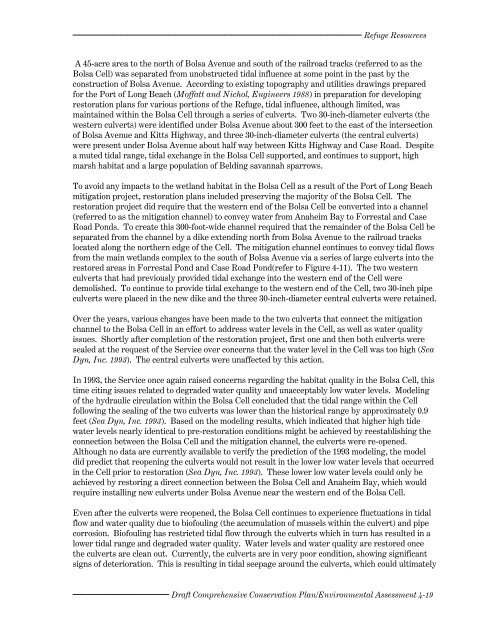Chapters 1 - U.S. Fish and Wildlife Service
Chapters 1 - U.S. Fish and Wildlife Service
Chapters 1 - U.S. Fish and Wildlife Service
Create successful ePaper yourself
Turn your PDF publications into a flip-book with our unique Google optimized e-Paper software.
Refuge Resources<br />
A 45-acre area to the north of Bolsa Avenue <strong>and</strong> south of the railroad tracks (referred to as the<br />
Bolsa Cell) was separated from unobstructed tidal influence at some point in the past by the<br />
construction of Bolsa Avenue. According to existing topography <strong>and</strong> utilities drawings prepared<br />
for the Port of Long Beach (Moffatt <strong>and</strong> Nichol, Engineers 1988) in preparation for developing<br />
restoration plans for various portions of the Refuge, tidal influence, although limited, was<br />
maintained within the Bolsa Cell through a series of culverts. Two 30-inch-diameter culverts (the<br />
western culverts) were identified under Bolsa Avenue about 300 feet to the east of the intersection<br />
of Bolsa Avenue <strong>and</strong> Kitts Highway, <strong>and</strong> three 30-inch-diameter culverts (the central culverts)<br />
were present under Bolsa Avenue about half way between Kitts Highway <strong>and</strong> Case Road. Despite<br />
a muted tidal range, tidal exchange in the Bolsa Cell supported, <strong>and</strong> continues to support, high<br />
marsh habitat <strong>and</strong> a large population of Belding savannah sparrows.<br />
To avoid any impacts to the wetl<strong>and</strong> habitat in the Bolsa Cell as a result of the Port of Long Beach<br />
mitigation project, restoration plans included preserving the majority of the Bolsa Cell. The<br />
restoration project did require that the western end of the Bolsa Cell be converted into a channel<br />
(referred to as the mitigation channel) to convey water from Anaheim Bay to Forrestal <strong>and</strong> Case<br />
Road Ponds. To create this 300-foot-wide channel required that the remainder of the Bolsa Cell be<br />
separated from the channel by a dike extending north from Bolsa Avenue to the railroad tracks<br />
located along the northern edge of the Cell. The mitigation channel continues to convey tidal flows<br />
from the main wetl<strong>and</strong>s complex to the south of Bolsa Avenue via a series of large culverts into the<br />
restored areas in Forrestal Pond <strong>and</strong> Case Road Pond(refer to Figure 4-11). The two western<br />
culverts that had previously provided tidal exchange into the western end of the Cell were<br />
demolished. To continue to provide tidal exchange to the western end of the Cell, two 30-inch pipe<br />
culverts were placed in the new dike <strong>and</strong> the three 30-inch-diameter central culverts were retained.<br />
Over the years, various changes have been made to the two culverts that connect the mitigation<br />
channel to the Bolsa Cell in an effort to address water levels in the Cell, as well as water quality<br />
issues. Shortly after completion of the restoration project, first one <strong>and</strong> then both culverts were<br />
sealed at the request of the <strong>Service</strong> over concerns that the water level in the Cell was too high (Sea<br />
Dyn, Inc. 1993). The central culverts were unaffected by this action.<br />
In 1993, the <strong>Service</strong> once again raised concerns regarding the habitat quality in the Bolsa Cell, this<br />
time citing issues related to degraded water quality <strong>and</strong> unacceptably low water levels. Modeling<br />
of the hydraulic circulation within the Bolsa Cell concluded that the tidal range within the Cell<br />
following the sealing of the two culverts was lower than the historical range by approximately 0.9<br />
feet (Sea Dyn, Inc. 1993). Based on the modeling results, which indicated that higher high tide<br />
water levels nearly identical to pre-restoration conditions might be achieved by reestablishing the<br />
connection between the Bolsa Cell <strong>and</strong> the mitigation channel, the culverts were re-opened.<br />
Although no data are currently available to verify the prediction of the 1993 modeling, the model<br />
did predict that reopening the culverts would not result in the lower low water levels that occurred<br />
in the Cell prior to restoration (Sea Dyn, Inc. 1993). These lower low water levels could only be<br />
achieved by restoring a direct connection between the Bolsa Cell <strong>and</strong> Anaheim Bay, which would<br />
require installing new culverts under Bolsa Avenue near the western end of the Bolsa Cell.<br />
Even after the culverts were reopened, the Bolsa Cell continues to experience fluctuations in tidal<br />
flow <strong>and</strong> water quality due to biofouling (the accumulation of mussels within the culvert) <strong>and</strong> pipe<br />
corrosion. Biofouling has restricted tidal flow through the culverts which in turn has resulted in a<br />
lower tidal range <strong>and</strong> degraded water quality. Water levels <strong>and</strong> water quality are restored once<br />
the culverts are clean out. Currently, the culverts are in very poor condition, showing significant<br />
signs of deterioration. This is resulting in tidal seepage around the culverts, which could ultimately<br />
Draft Comprehensive Conservation Plan/Environmental Assessment 4-19

















